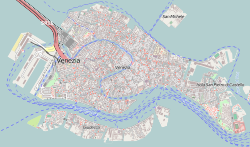| Levantine Synagogue | |
|---|---|
Italian: Scola Levantina | |
 The synagogue façade, in 2014 | |
| Religion | |
| Affiliation | Judaism |
| Rite | Nusach Sefarad |
| Ecclesiastical or organisational status | Synagogue |
| Status | Active |
| Location | |
| Location | Campiello delle Scuole, Venetian Ghetto, Venice, Veneto |
| Country | Italy |
Location of the synagogue in Venice | |
| Coordinates | 45°26′41″N12°19′32″E / 45.44472°N 12.32556°E |
| Architecture | |
| Architects | |
| Type | Synagogue architecture |
| Style | |
| Founder | Levantine Jews |
| Completed | 1541 |
| Materials | Stone |
| [1] | |
The Levantine Synagogue (Italian : Scola Levantina) is a Jewish congregation and synagogue, that is located on Campiello delle Scuole, in the Venetian Ghetto of Venice, Italy. Designed by Baldassare Longhena and Andrea Brustolon in a mix of the Baroque and Mannerist styles, the synagogue was completed in 1541. The congregation worships in the Sephardic rite. [2]

